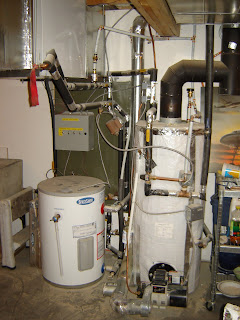While reading this book, (published in 2005--back when the markets were roaring along making lots of money), I came across the following passage:
"The best information we have is that we will have passed the point of world peak oil production sometime between the years 2000 and 2008. The date is inexact for several resons. One is that the reported reserves (oil left in the ground) of private sector and nationalized oil companies tend to be routinely overestimated, variously to benefit the share price of the stock, or to gain export quota advantages in international markets, as in the case of Organization of Petroleum Exporting Countries (OPEC) members. Another reasons is the "peak" will tend to manifest in several years of oscillating market instability, a volatile period of recurring price shocks and consequential recession dampening demand and price, presage a terminal decline. The peak therefore will only be seen in a "rearview mirror" once the terminal decline begins. Signs of sustained market instability therefore tend to suggest the earlier onset of peak but would not be probable except in hindsight."This was written three years ago. Doesn't this very pointedly describe our current economic situation? It looks like Jim nailed it.
As Robert Heinberg described in his article "Say Good Bye to Peak Oil", the one-two punch of rapid oil field declines (IEA estimates global average oil field decline of 6% / year) coupled with the current low oil prices causing lack of investment in new development, has likely lead to peak global oil production having occurred in July 2008. Is this the peak starting to appear in our "rearview" mirror?

With respect to our current global economic instability, Jeff Rubin of CIBC World Markets has identified that the current global recession is the result of high oil prices. Again, Jim nailed it - volatile energy prices, price shocks followed by recession with dampened demand and prices
.

Charts from CIBC World Markets' October 31st, 2008 report.
All in all, the forecast presented in the preamble to "The Long Emergency" seem to be panning out. So, the Long Emergency might be a good description for the years to come.
Happy New Year.






